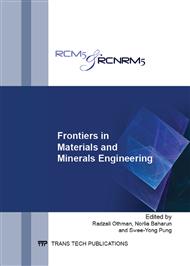[1]
M. IrimiaVladu, N. S. Sariciftci, S. Bauer, Exotic materials for bio-organic electronics, J. Mater. Chem. 21 (2011) 1350-1361.
DOI: 10.1039/c0jm02444a
Google Scholar
[2]
C. J. Bettinger, Z. Bao, Biomaterials-based organic electronic devices, Polym. Int. 59 (2010) 563-567.
Google Scholar
[3]
J. Chang, C. Wang, C. Huang, T. Tsai, T. Guo, T. Wen, Chicken albumen dielectrics in organic field-effect transistors, Adv. Mater. 23 (2011) 4077-4081.
DOI: 10.1002/adma.201102124
Google Scholar
[4]
C. Wang, C. Hsieh, J. Hwang, Flexible organic thin-film transistors with silk fibroin as the gate dielectric, Adv. Mater. 23 (2011) 1630-1634.
DOI: 10.1002/adma.201004071
Google Scholar
[5]
E. D. Glowacki, M. Irimia-Vladu, Natural and nature-inspired materils in organic electronics, SPIE Newsroom (2012).
DOI: 10.1117/2.1201201.004054
Google Scholar
[6]
L. Q. Khor, K. Y. Cheong, Extracted natural Aloe vera paste as novel dielectric material, Appl. Phys. A Mater. Sci. Proc. (2013). (Maniscript under review).
Google Scholar
[7]
P. B. Messersmith, E. P. Giannelis, Synthesis and characterization of layered silicate-epoxy nanocomposites, Chem. Mater. 6 (1994) 1719-1725.
DOI: 10.1021/cm00046a026
Google Scholar
[8]
R. Gensler, P. Gröppel, V. Muhrer, N. Müller, Application of nanoparticles in polymers for electronics and electrical engineering, Part. Part. Syst. Charact. 19 (2002) 293-299.
DOI: 10.1002/1521-4117(200211)19:5<293::aid-ppsc293>3.0.co;2-n
Google Scholar
[9]
S. Singha, M. J. Thomas, Permittivity and tan delta characteristics of epoxy nanocomposites in the frequency range of 1 MHz-1 GHz, Dielectr. Electr. Insul. 15 (2008) 2-11.
DOI: 10.1109/t-dei.2008.4446731
Google Scholar
[10]
N. M. Mohsen, R. G. Craig, F. E. Filisko, Effects of curing time and filler concentration on curing and postcuring of urethane dimethacrylate composites: a microcalorimetric study, J. Biomed. Mater. Res. 40 (1998) 224-232.
DOI: 10.1002/(sici)1097-4636(199805)40:2<224::aid-jbm7>3.0.co;2-n
Google Scholar
[11]
C. S. Kim, S. J. Jo, S. W. Lee, W. J. Kim, H. K. Bail, S. J. Lee, D.K. Hwang, S. Im, Low-voltage organic transistors: the effect of a spin-coated smoothing layer on device performance, Semicond. Sci. Tech. 21 (2006) 1022-1025.
DOI: 10.1088/0268-1242/21/8/006
Google Scholar
[12]
C. Sun, T. P. Juan, Y. Hsu, Y. Liu, Effect of processing temperature on characteristics of metal-ferroelectric (BiFeO3)-insulator (HfLaO)-silicon capacitors, Thin Solid Films 518 (2010) 7433-7436.
DOI: 10.1016/j.tsf.2010.05.011
Google Scholar
[13]
J. Y. Son, W. J. Maeng, W. Kim, Y. H. Shin, H. Kim, Interface roughness effect between gate oxide and metal gate on dielectric property, Thin Solid Films 517 (2009), 3892-3895.
DOI: 10.1016/j.tsf.2009.01.117
Google Scholar


